Ben Chifley
| The Right Honourable Ben Chifley |
|
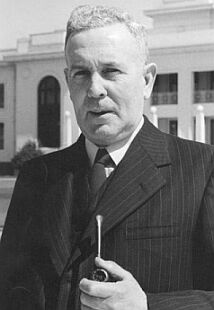 |
|
|
16th Prime Minister of Australia
Elections: 1946, 1949 |
|
|---|---|
| In office 13 July 1945 – 19 December 1949 |
|
| Preceded by | Frank Forde |
| Succeeded by | Robert Menzies |
| Constituency | Macquarie (New South Wales) |
|
|
|
| Born | 22 September 1885 Bathurst, New South Wales, Australia |
| Died | 13 June 1951 (aged 65) |
| Political party | Labor |
| Religion | Roman Catholic[1] |
Joseph Benedict Chifley (pronounced /ˈtʃɪfli/; 22 September 1885 – 13 June 1951), Australian politician and the 16th Prime Minister of Australia. Among his government's accomplishments were the post-war immigration scheme under Arthur Calwell, the establishment of Australian citizenship in 1949, the Snowy Mountains Scheme, over-viewing the foundation of airlines Qantas and TAA, a social security scheme for the unemployed, reorganising and enlarging the CSIRO, and the founding of the Australian Security Intelligence Organisation (ASIO). One of the few successful referendums to modify the Australian Constitution took place during his term.[2][3][4]
Contents |
Early life
Born in Bathurst, New South Wales,[2] Chifley was the son of a blacksmith of Irish Roman Catholic descent. He was one of four brothers and between the ages of five and 14 was raised mostly by his grandfather, who lost all his savings in the bank crash of 1892: Chifley acquired his lifelong dislike of the private banks early. He was educated at Roman Catholic schools in Bathurst, and joined the New South Wales Railways at 15.
Ben Chifley became an engine driver. He was one of the founders of the AFULE (the Australian Federated Union of Locomotive Enginemen)[5] and an active member of the Labor Party. In 1914 he married Elizabeth Mackenzie. Mackenzie was a staunch Presbyterian, and the couple exchanged wedding vows in a Presbyterian church. Chifley remained a practicing Catholic, but his marriage with a non-Catholic ignited criticisms among Catholic circles.[1] In 1917 he was one of the leaders of a prolonged strike which resulted in his being dismissed. He was reinstated by the Jack Lang New South Wales Labor government in 1920. He represented his union before industrial tribunals and taught himself industrial law.
Parliament
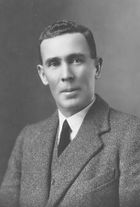
In 1928, at his second try, Chifley won the Bathurst-based seat of Macquarie in the House of Representatives. He was in general a supporter of the James Scullin government's economic policies, and in 1931 he became Minister for Defence. At the 1931 general election, the Scullin government fell and Chifley lost his seat. During the Depression he survived on his wife's family's money and his part-ownership of the Bathurst newspaper the National Advocate.
In 1935 the Lyons government appointed him a member of the Royal Commission on Banking, a subject on which he had become an expert. He submitted a minority report advocating that the private banks be nationalised.
Chifley finally won his seat back in 1940, and the following year he became Treasurer (finance minister) in John Curtin's Labor government. Although Frank Forde was Curtin's deputy, Chifley became the minister Curtin most relied on, and he controlled most domestic policy while Curtin was preoccupied with the war effort. He presided over the massive increases in government expenditure and taxation that accompanied the war, and imposed a regime of economic regulation that made him very unpopular with business and the press.
Prime minister
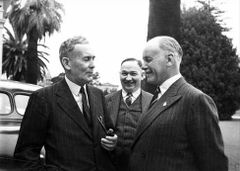
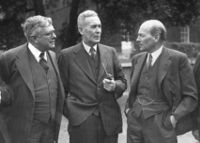
When Curtin died in July 1945, Forde became (very briefly) Prime Minister, but Chifley defeated him in the leadership ballot and replaced him six days later. Once the war ended, normal political life resumed, and Chifley faced Robert Menzies and his new Liberal Party in the 1946 election, which Chifley comfortably won. In the post-war years, Chifley maintained wartime economic controls including the highly unpopular petrol rationing. He did this partly to help Britain in its postwar economic difficulties.
Feeling secure in power, Chifley decided it was time to advance towards Labor's objective of democratic socialism. Amongst other measures, Chifley passed legislation to establish a free formulary of essential medicines.[6] This was successfully opposed in the Australian High Court by the British Medical Association (precursor of the Australian Medical Association)[7] Chifley then organised one of the few successful constitutional referenda to insert a new section 51xxiiiA which permitted federal legislation over pharmaceutical benefits.[8] The subsequent federal legislation was deemed constitutional by the High Court.[9] This paved the way for the Pharmaceutical Benefits Scheme.[10]
In 1947 Chifley announced the government's intention to nationalise the banks. This provoked massive opposition from the press, and middle-class opinion turned against Labor. The High Court of Australia eventually found Chifley's legislation to be unconstitutional.
In the winter of 1949 a prolonged and bitter strike in the coal industry caused unemployment and hardship. Chifley saw the strike as a move by the Communist Party to challenge Labor's place as the party of the working class, and he sent in the army to break the strike. Despite this, Menzies exploited the rising Cold War hysteria to portray Labor as soft on Communism.
These events, together with a perception that Chifley and Labor had grown increasingly arrogant in office, led to the sweeping Liberal election victory of December 1949. Chifley suffered a 48-seat swing—still the worst defeat of an incumbent government at the federal level in Australia. Chifley was now aged 64 and in poor health (like Curtin he was a lifelong smoker), but he refused to retire. Labor had retained control of the Senate, and Chifley took advantage of this to bring misery to the Menzies government at every turn. Menzies responded by introducing a bill to ban the Communist Party of Australia. He expected Chifley to reject it and give him an excuse to call double dissolution election. Menzies apparently hoped to repeat his "soft-on-Communism" theme to win a majority in both chambers. However, Chifley let the bill pass (it was ultimately thrown out by the High Court)
However, when Chifley rejected Menzies' banking bill a few months later, Menzies called a double dissolution election in April 1951. He succeeded in winning control of both Houses at the election.
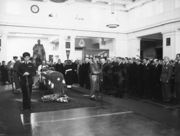
A few weeks later Chifley died of a heart attack in his room at the Kurrajong Hotel in Canberra (he had lived there throughout his prime ministership, having refused to reside at The Lodge). Menzies heard of Chifley's demise while attending an official event at the Albert Hall in Canberra, to mark fifty years of Australian Federation. Normally impassive, "Ming the Merciless" (as his foes called him) had difficulty on this occasion in fighting back tears; and he ordered that the function be brought to an end, in homage to his predecessor and adversary, whom (for all the previous decade's political quarrels) he had never ceased to respect as a person.
"Chifley legend"
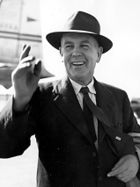
More than 30 years after his death, Chifley's name still aroused partisan passions. In 1987 the New South Wales Labor government decided to name the planned new university in Sydney's western suburbs Chifley University. When, in 1989, a new Liberal government renamed it the University of Western Sydney, controversy broke out. According to a debate on the topic, held in 1997 after the Labor Party had regained government, the decision to rename Chifley University reflected a desire to attach the name of Western Sydney to institutions of lasting significance, and that idea ultimately received the support of Bob Carr, later the Premier of New South Wales.[11]
Chifley had lived apart from his wife for many years: his secretary, Phyllis Donnelly, was with him when he died. Long-held suspicions that she had been his lover were confirmed in David Day's 2001 biography.
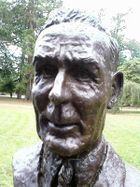
The light on the hill
"I try to think of the labour movement, not as putting an extra sixpence into somebody's pocket, or making somebody Prime Minister or Premier, but as a movement bringing something better to the people, better standards of living, greater happiness to the mass of the people. We have a great objective - the light on the hill - which we aim to reach by working the betterment of mankind not only here but anywhere we may give a helping hand. If it were not for that, the Labour movement would not be worth fighting for." (excerpt from "The Light on the Hill" speech, 12 June 1949)
Honours
Places and institutions have been named after Chifley. The main library of the Australian National University, Chifley Library, is named after him. There is an Australian hotel chain, a central Sydney building and square, and two suburbs (in Canberra and Sydney), named after him. Several public high schools in Western Sydney are now known as Chifley College, as well as a grouping of dormitories from the Bathurst campus for CSU collectively named as Chifley Halls in 2007. Many of his reforms also remain in place.
In 1975 he was honoured on a postage stamp bearing his portrait issued by Australia Post.[12] Chifley Tower in Sydney, New South Wales is named in Chifley's honour.
See also
- First Chifley Ministry
- Second Chifley Ministry
- 1949 Australian coal strike
- The light on the hill
Notes and references
- ↑ 1.0 1.1 Duncan (2001), p. 163
- ↑ 2.0 2.1 "The Rt Hon Ben Chifley". Australian Labor Party. http://www.alp.org.au/people/chifley_ben.php. Retrieved 2007-12-11.
- ↑ "Significant Events in ASIO's History". Australian Security Intelligence Organisation. http://www.asio.gov.au/About/Content/History.aspx. Retrieved 2007-12-11.
- ↑ "Chifley, Joseph Benedict (Ben) (1885 - 1951)". Australian Dictionary of Biography. http://www.adb.online.anu.edu.au/biogs/A130460b.htm. Retrieved 2007-06-30.
- ↑ "A.F.U.L.E. History". www.afule.org.au. http://www.afule.org.au/about.htm#hist. Retrieved 2007-09-03.
- ↑ Sloan C. A History of the Pharmaceutical Benefits Scheme 1947-1992. Canberra AGPS 1995) p12
- ↑ AG Vic (ex rel Dale and ors) v Cth (the Pharmaceutical Benefits Case) (1945) 71 CLR 237.
- ↑ David Day. Chifley Harper Collins Sydney 2001 pp443-444. It also authorised federal legislation over medical and dental services (but not so as to authorise any form of civil conscription).
- ↑ Federal Council of the British Medical Association in Australia v Cth (1949) 79 CLR 201.
- ↑ National Health Act 1953(Cth).
- ↑ "University of Western Sydney Bill - 19/11/1997 - 2R - NSW Parliament". Parliament.nsw.gov.au. 1997-11-19. http://www.parliament.nsw.gov.au/Prod/Parlment/HansArt.nsf/0/ca256d11000bd3aa4a25656e000f21b6?OpenDocument. Retrieved 2010-04-18.
- ↑ http://www.australianstamp.com/images/large/0011200.jpg
Bibliography
- Duncan, Bruce, Crusade or conspiracy?: Catholics and the anti-communist struggle in Australia, UNSW Press, 2001, ISBN 0868407313
Further reading
- Chifley, Ben (1952), Things Worth Fighting For (collected speeches), Melbourne University Press, Parkville, Victoria.
- Crisp, L.F. (1961), Ben Chifley: A Political Biography, Longman, Green and Co, Melbourne, Victoria.
- Day, David (2001), Chifley, HarperCollins, 2001
- Hughes, Colin A (1976), Mr Prime Minister. Australian Prime Ministers 1901-1972, Oxford University Press, Melbourne, Victoria, Ch.17. ISBN 0 19 550471 2
- Makin, Norman (1961), Federal Labour Leaders, Union Printing, Sydney, New South Wales, Pages 122-131.
- Waterson, Duncan (1993), Australian Dictionary of Biography Vol. 13 A-D pp. 412–420, Melbourne University Press, Carlton, Victoria.
External links
- "Ben Chifley". Australia's Prime Ministers. National Archives of Australia. http://primeministers.naa.gov.au/primeministers/chifley/. Retrieved 29 June 2010.
- Waterson, D. B. (1993). "Chifley, Joseph Benedict (Ben) (1885 - 1951)". Australian Dictionary of Biography. Australian National University. http://www.adb.online.anu.edu.au/biogs/A130460b.htm. Retrieved 29 June 2010.
- "Ben Chifley". National Museum of Australia. http://www.nma.gov.au/education/school_resources/websites_and_interactives/primeministers/ben_chifley/. Retrieved 29 June 2010.
- Chifley Research Centre
- Chifley College, Sydney
| Political offices | ||
|---|---|---|
| Preceded by John Daly |
Minister for Defence 1931–1932 |
Succeeded by George Pearce |
| Preceded by Sir Arthur Fadden |
Treasurer of Australia 1941–1949 |
Succeeded by Sir Arthur Fadden |
| Preceded by Frank Forde |
Prime Minister of Australia 1945–1949 |
Succeeded by Robert Menzies |
| Preceded by Robert Menzies |
Leader of the Opposition 1949–1951 |
Succeeded by H.V. Evatt |
| Parliament of Australia | ||
| Preceded by Arthur Manning |
Member for Macquarie 1928–1931 |
Succeeded by John Lawson |
| Preceded by John Lawson |
Member for Macquarie 1940–1951 |
Succeeded by Anthony Luchetti |
| Party political offices | ||
| Preceded by John Curtin |
Leader of the Australian Labor Party 1945–1951 |
Succeeded by H.V. Evatt |
|
|||||
|
|||||